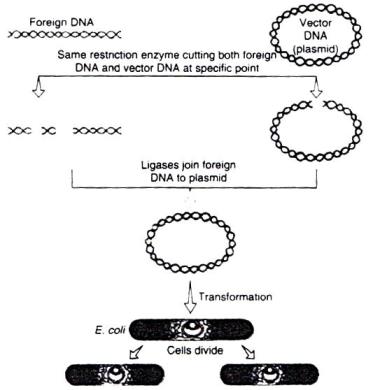Class 12-science NCERT Solutions Biology Chapter 10 - Biotechnology and its Applications
Biotechnology and its Applications Exercise 186
Solution 1
The meristem of a plant is best suited for making virus-free plants. This is because even when the plant is infected by a virus, it is the meristem region (apical and axillary meristem) which remains infection-free as compared to the rest of the plant. Hence, scientists remove the axillary and apical meristem of the diseased plant and grow it in vitro to obtain a disease-free and healthy plant. Scientists have obtained virus-free plants of banana, sugarcane and potato using this method.
Solution 2
Few major advantages of producing plants by micropropagation are as follows:
• It helps in the propagation of a large number of plants in a short span of time.
• The plants produced are identical to the parent plant.
• It leads to the production of healthier plantlets, which exhibit better disease-resistance.
Solution 3
Carbon sources such as sucrose, vitamins, minerals, water, agar-agar, auxins and gibberellins, and amino acids are all included in the medium used to propagate an explant in vitro.
Solution 4
(c) Toxin is inactive. In bacteria, the toxin is present in an inactive form called prototoxin. This gets converted into the active form when it enters the body of an insect.
Biotechnology and its Applications Exercise 187
Solution 5
Transgenic bacteria are bacteria in which a foreign gene is introduced into its genome. For example, two DNA sequences coding for A and B chains of human insulin introduced into the plasmid of E. coli start producing insulin chains.
Solution 6
Advantages of GM crops:
(i) Genetic modification has made crops more tolerant to abiotic stresses (cold, drought, heat, salt).
(ii) Viral resistance can be introduced.
(iii) Over ripening losses can be reduced. Example: Flavr Savr tomato
(iv) Enhanced nutritional value of food. Example: Golden Rice
(v) Reduced reliance on chemical pesticides.
Disadvantages of GM crops:
(i) Transgenes in crop plants can endanger native species. Example: The gene for Bt toxin expressed in pollen may end natural pollinators such as honey bees.
(ii) Weeds also become resistant.
(iii) Products of transgenes may be allergic or toxic.
(iv) They cause damage to the natural environment.
Solution 7
Cry proteins are toxic proteins (insecticidal proteins) secreted by Bacillus thuringiensis in crystal form during a particular phase of their growth. The toxin is coded by a gene called cry.
The genes encoding cry proteins called Bt toxin genes were isolated from
B. thuringiensis and incorporated into several crop plants such as Bt cotton,
Bt corn etc. to provide resistance against insect pests.
Solution 8
Gene therapy: It is a collection of methods which allows correction of a gene defect that has been diagnosed in a child or embryo. In gene therapy, normal genes are inserted into a person's cells and tissues to treat a hereditary defect. Gene therapy is being tried for sickle cell anaemia and severe combined immunodeficiency (SCID).
In some children, ADA deficiency can be cured by bone marrow transplantation. In others, it can be treated by enzyme replacement therapy, in which functional ADA is given to the patient by injection. However, both of these approaches are not completely curative.
In gene therapy, lymphocytes from the blood of the patient are grown in culture outside the body. A functional ADA cDNA (using a retroviral vector) is then introduced into these lymphocytes, which are subsequently returned to the patient. Because these cells are not immortal, the patient requires periodic infusion of such genetically engineered lymphocytes. However, if the gene isolated from marrow cells producing ADA is introduced into cells at early embryonic stages, the disease could be cured permanently.
Solution 9

Solution 10
Oil is a lipid synthesised by the condensation of one molecule of glycerol with three molecules of fatty acids. Thus, the oil from the seeds can be removed by preventing the synthesis of either glycerol or the enzyme lipase which catalyses the synthesis of oil. It can be achieved by knocking out the genes coding for the enzyme lipase or the enzyme required for the synthesis of glycerol.
Solution 11
Rice does not contain vitamin A or its immediate precursors. By inserting transgenes in rice plants, it is capable of synthesising beta-carotene, the precursor of vitamin A. The rice produced is yellow in colour. Therefore, it is called golden rice. It prevents blindness.
Solution 12
No. Human blood does not have the enzymes nucleases and proteases. In human beings, blood serum contains different types of protease inhibitors, which protect the blood proteins from being broken down by the action of proteases. The enzyme nuclease catalyses the hydrolysis of nucleic acids which are absent in blood.
Solution 13
For making any oral drug or nutritional supplement, the action of digestive enzymes has to be taken into account. Most of the antibiotics and vitamin supplements are made in capsule form to prevent the action of HCl in the stomach. For protein preparation, the major source is groundnut shells. The protein extracted from the source is predigested so as to make it absorbable by the digestive system.

